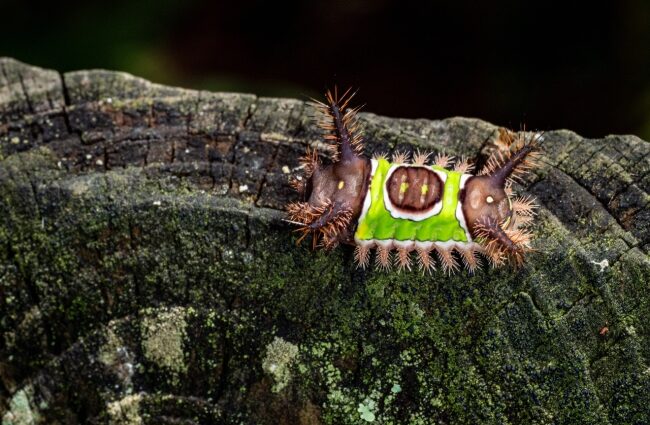My first close-up photograph subjects, using a macro lens, were (yawn) flowers. Artfully composed plant photos can be beautiful, but as subjects mutely willing to pose all day, they don’t offer much of a challenge. Fortunately, in the course of perusing the flora, I noticed the fascinating creatures buzzing, flitting and sometimes gnawing among the plant life. Now there was a challenge—capturing insects and spiders, not in a net, but in a photo—and the hunt was on. Like any hunter, I have plenty of stories of the ones that got away, and the majority of my photos end up in my Mac’s trash can. Macro lenses have a very shallow depth of field, and the focal distance is right next to an organism that is rarely in the mood to stick around for a photo shoot. A few millimeters of movement, whether from the camera or the subject, can make the difference between a sharply focused image and a blurry mess. I use a dual flash attached to the front of the lens and a fast shutter speed, which helps compensate for the movement.
As I spent more time observing insect and spider behavior, and began to accumulate some decent images, I bought some guidebooks and used on-line resources, such as Bugguide.net, to try to identify and learn more about these creatures. While some uniquely marked insects/spiders are easy to name, others can only be identified at the species level by capturing the tiny beast and examining it under a microscope for some obscure feature like the number of segments on a metatarsal or the structure of the genitalia. I leave that kind of work to the professional entomologists. My ethic is to capture them on camera as they are in the wild. On June 10, 2023, I participated in a BioBlitz, sponsored by MountainTrue and Friends of Big Ivy in the Craggy Mountains of Pisgah National Forest, where we photographed and posted all the species of plants and animals we could find by app or on-line at iNaturalist. I have continued to post photos to iNaturalist.org, where experts confirm or correct my initial stab at identification. If the photo identification is established as “research grade” at the species level, it is added to a huge, constantly expanding research database of species from all over the world.
The following photos, all of which were taken in Western North Carolina or Eastern Tennessee, are but a few from my growing collection. While many insects and spiders are works of art in themselves, I’m especially thrilled when I can snap a photo that illustrates a slice of wildlife drama—survival of the fittest in action (e.g., the Robber Fly at dinner).
Hidden Appalachia Gallery
**All images were photographed by Jim Clark©



















Jimmy: These photos are stunning! Thank you for sharing.
Thanks Eddie—kudos also to the Appalachia Bare staff for the well-designed formatting.